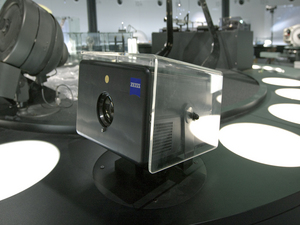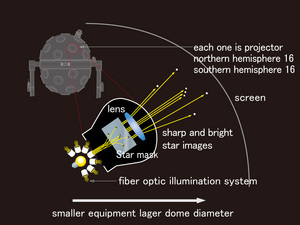Nagoya City Science Museum
TOP > Exhibition Guide > Keyword Search > Starting with "Z" > ZEISS > Fiber Optics Planetarium
Fiber Optics Planetarium



Purpose of Exhibition
The Zeiss Mark IX Star Projector, installed in the dome on the sixth floor of the Astronomy Building, employs fiber-optic system, which is more advanced optics than lens projection. The star ball incorporates 32 individual star projectors.
This exhibit will show you the same one as those 32 units, which can cast stars around Orion. On occasional public talks, the sky will be projected on the gallery wall, and you can compare it with the image drawn by the Zeiss Mark IV, which served the former Astronomy Building from 1962 to 2010.
Additional Knowledge
[Invention of the Fiber Optic Projection]
Lens projection has a disadvantage: those projectors cast light through a star plate, a disk with holes drilled at stellar positions, each of which represents a star, but most of the light hits the surface and is scattered away. Consequently, the light from the lamp cannot be used effectively.
On the other hand, the advanced fiber optic projectors put fine glass threads, or fiberglass bundles, very close to the light source to capture the light without wasting it. The other end of each fiber is connected to the stellar positions on the star plate, and then the light is guided directly into the hole. Whit this new technology, the fiber optic system succeeded in reproducing a bright and sharp image of stars. This patent was granted in 1988 in the U.S. and in the former East and West Germany.
This page was last edited on 8 July 2022.
Article by: Astronomy Section
